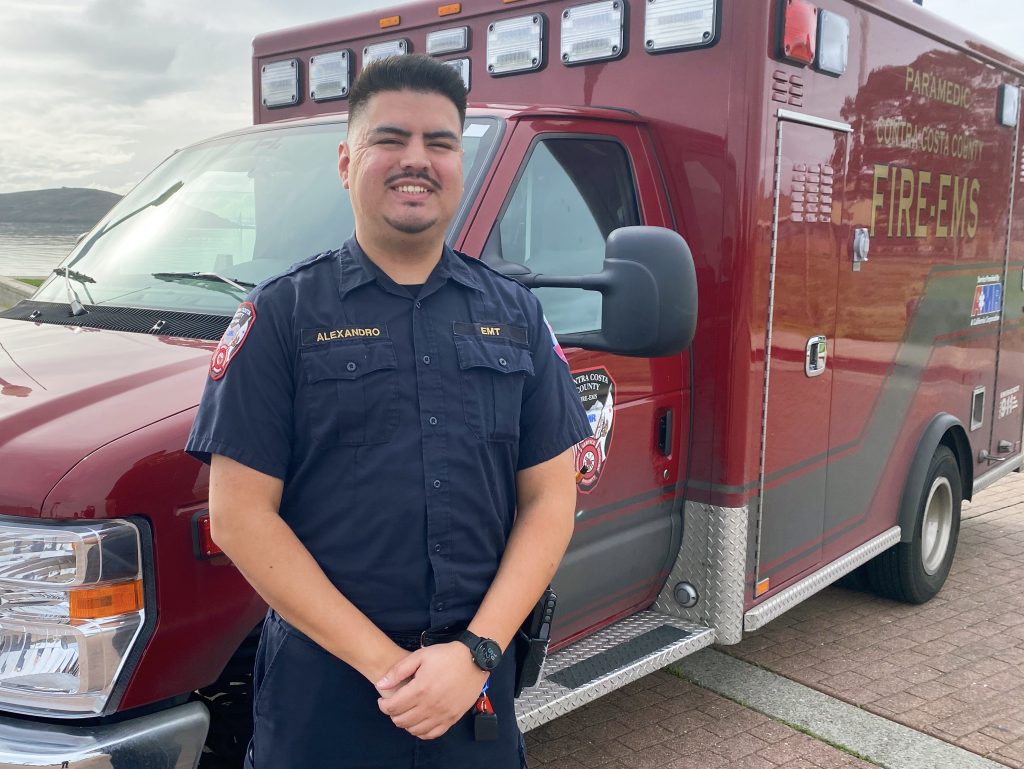EMT Alexandro Moya was still in training and working as a casino security guard when he saved his first life

Alexandro Moya’s life story now includes a chapter on how he once saved another man’s life, and when he looks back to tell it, he’ll have two agencies to thank—California Community Colleges (CCC) and the Workforce Development Board of Contra Costa County (WDBCCC).
Moya, who is 28 years old, deserves most of the credit, of course. While working as a security officer at the San Pablo Lytton Casino, he instinctively jumped into action when a man standing at the snack bar collapsed into a potentially dying gasp for air. Moya pumped the breath of life back into the stricken fellow, then hooked him up for a reviving jolt of energy to restart his heart.
Along with his gumption, Moya had an action plan burned into his muscle memory, thanks to his enrollment several weeks earlier in Contra Costa College’s EMT 4 Equity program. This program, paid for by the California Workforce Development Board (CWDB) through its Workforce Accelerator Fund and developed by the WDBCCC, was started to help un- and under-employed people train to become emergency medical technicians.
“I remembered from school, the term ‘agonal gasp.’ It’s essentially the body’s last effort to supply oxygen. Soon after, he ‘coded’—his heart stopped beating.”
Alexandro Moya, Contra Contra College Graduate and Emergency Medical Technician
Not long after the life-saving night in the spring of 2022, Moya completed the EMT program. He has since moved on from casino security guard to his new job as an EMT for American Medical Response in Contra Costa County. These days, Moya routinely compresses chests and jumpstarts hearts with his trusty automated external defibrillator (AED), all of it part of a day’s work.
“These are people’s lives,” Moya says. “People are looking at me as a servant, to take care of them, to provide care, and in the worst-case scenarios, save them from a life-threatening situation.”
From the 15 bucks and change he was making as a security guard at the casino, Moya now pulls down $23 an hour, with lots of opportunity for overtime. A single guy, he says he racks up as much as 32 hours of OT a week when he feels up to it.
“I’m just focused on my career right now,” says the San Pablo resident. “Lots of learning.”
Moya represents a case study in the aims of Vision 2030, a collection of initiatives overseen by the California Community Colleges Chancellor’s Office to lift the working poor into the economic mainstream and ensure more equity and access to education and career training. Vision 2030’s goals also include bolstering the state’s healthcare workforce and it encourages collaboration between community colleges and regional workforce development boards like the WDBCCC.
“This project is an example of what can happen when people who need opportunities the most are supported throughout training and ensured of a quality job upon completion,” says WDBCCC Program Manager Jed Silver. “We were thrilled that CWDB was willing to take a chance on this pilot, and participants like Alex were the reward and reason for its success.”
The EMT 4 Equity program ran from June 2022 to March 2024, and its success prompted the creation of another collaborative effort between the college and regional workforce board called the Paramedic 4 Equity (P4E) program, which Silver says is “going strong.” The P4E program enables EMTs to participate in apprenticeships to further develop their skills to become paramedics.
Interestingly, Moya enrolled at UC Berkeley right out of Richmond High School, and made it into his third year there before he decided that route wasn’t for him. He scuffled through janitorial work and then the security guard gig before he found out about the EMT program at Contra Costa College.
A life’s path of community service revealed itself to him as he pumped life itself into a fallen gambler’s lungs on a casino floor.
“He had stopped breathing,” Moya recalls. “I remembered from school, the term ‘agonal gasp.’ It’s essentially the body’s last effort to supply oxygen. Soon after, he ‘coded’—his heart stopped beating.”
After Moya resuscitated the man, the fire department paramedics rushed the victim to the hospital for a new deal in the card-deck of life.
“Later on, I was doing a ride along with the EMT school, and one of the supervisors talked to me and informed me that my efforts saved the patient,” Moya says. “There was a lot of stress involved. It was very good that we were able to do that.”
Now Moya wants to do more. While saving lives, he interacts with a lot with police officers from various Bay Area agencies, and says he’s thinking about enrolling in a police academy. There, again, the CCC may play a role, as eight community colleges offer police academy programs statewide.
“I’m ready to try it out,” Moya says.
Another chapter for the biography.
For more information about the Workforce Development Board of Contra Costa County, visit www.wdbccc.com. To learn more about California Community Colleges Chancellor’s Office and Vision 2030, go to www.cccco.edu.
Written by Andy Furillo
| Regions | Classes & Topics |
|---|---|
| Bay Area California | Workforce Development Board |